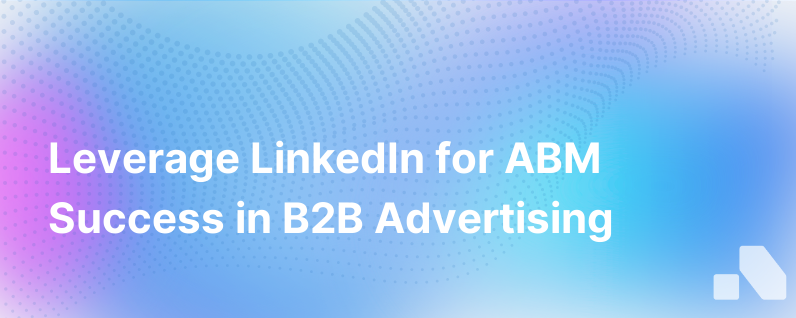
In the B2B industry, finding successful advertising strategies can feel like searching for a needle in a haystack of consumer-focused noise. As business developers aim for higher precision in their marketing outreach, LinkedIn emerges as a potent arrow in their quiver, especially when it comes to Account-Based Marketing (ABM).
ABM is a strategy that concentrates resources on a set of target accounts within a market. It employs personalized campaigns designed to resonate with each account, using highly tailored messaging based on the specific attributes and needs of the account. And, when it comes to B2B, LinkedIn is arguably the most targeted platform you can leverage for ABM.
Here are four ways B2B companies can utilize LinkedIn to drive their ABM efforts:
1. Advanced Segmentation and Targeting
A significant advantage of LinkedIn for ABM is its powerful targeting capabilities. With an array of filters like industry, company size, job function, seniority level, and more, you can pinpoint the decision-makers of your target accounts with laser precision.
How to leverage:
- Create a Matched Audiences campaign. Start by uploading a list of email addresses associated with key individuals at your target companies.
- Layer additional targeting criteria. Apart from company names and email lists, add additional criteria to drill down to an even more refined audience that perfectly matches your buyer profile.
- Use LinkedIn's Account Targeting feature. Provide a list of company names and let LinkedIn's data magic create a custom segment for your ABM ads.
2. Personalized Content Delivery
LinkedIn takes ABM a step further with the ability to create and deliver content that’s personalized for each target account. From Direct Sponsored Content campaigns to InMail messages, the personalization possibilities are abundant.
How to leverage:
- Direct Sponsored Content campaigns. Build ad creatives and messages tailored specifically for key decision-makers at each target company, encouraging engagement right in their LinkedIn feed.
- Sponsored InMail. Send personalized LinkedIn InMails to targets, which are only delivered when users are active, ensuring higher open rates.
- Dynamic ads. Make use of dynamic ads which personalize the creative to include the user’s own LinkedIn profile data like photo, job title, and more.
3. Intent-Based Advertising
Understanding the intent and behavior of your target accounts can dramatically improve the chances of your LinkedIn campaign resonating with them. LinkedIn’s Insight Tag, a lightweight JavaScript code you can add to your website, tracks conversions and retargets website visitors when they're browsing LinkedIn.
How to leverage:
- Use LinkedIn Insight Tag. Monitor which LinkedIn users are visiting your website and what content they’re interacting with.
- Create retargeting campaigns. Tailor your LinkedIn ads based on the pages prospects have visited on your site, showing them relevant content that addresses their pain points or interests.
- Leverage LinkedIn's interest targeting. Use LinkedIn’s data on user content engagements to direct ads to users who have shown interest in relevant topics.
4. Sales and Marketing Alignment
Sales and marketing alignment is the cornerstone of successful ABM campaigns. LinkedIn’s Sales Navigator tool aids in this alignment by providing sales teams with necessary insights into target accounts and leaders, including shared connections, interactions, and CRM information.
How to leverage:
- Integrate Sales Navigator with LinkedIn Campaign Manager. Bring lead and account lists from Sales Navigator into your advertising platform.
- “Highways of communication.” Encourage salespeople to use shared connections to warm up leads.
- Sales Navigator TeamLink. Extend your network to your entire company's LinkedIn network, uncovering the best path to reach the decision-makers at target accounts.
Let’s break down a hypothetical scenario where these strategies get put into action:
Imagine a B2B software startup specializing in AI-driven analytics for retail businesses. The startup's ABM strategy targets top-tier retail chains looking to elevate their analytics capabilities.
-
The startup begins by identifying 50 key retail chains to target and filters them through LinkedIn's Matched Audience feature for precise ad targeting.
-
Through Direct Sponsored Content, they release a series of articles and thought leadership pieces, personalized to each retail chain's business model, educating them about the untapped value in their customer data.
-
As retail chain personnel interact with these pieces, the startup uses the LinkedIn Insight Tag to monitor engagement levels on their website for a more tailored follow-up approach.
-
Their sales team then utilizes Sales Navigator to reach the decision-makers at the retail chains that have shown high engagement with their content, using warm introductions where possible for a soft sales pitch.
By integrating these strategies effectively, LinkedIn becomes not just a platform for networking but a sophisticated tool for targeted B2B marketing. As more companies tap into ABM, they find value in balancing broad-based brand awareness with the tactical precision of platforms like LinkedIn, creating rich pipelines of deeply engaged prospective clients.
In conclusion, LinkedIn provides a rich suite of ABM features that you can use to target, engage, and convert high-value accounts effectively. It remains an indispensable platform for B2B companies looking to align their sales and marketing teams towards the common goal of driving growth with key businesses. As platforms like Aomni make building and managing LinkedIn ABM campaigns increasingly efficient, savvy companies are capitalizing on these advanced capabilities to drive tangible results.